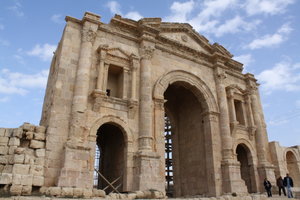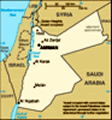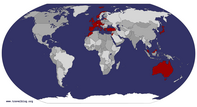Advertisement
Published: January 17th 2009

 Hadrian's Gate
Hadrian's Gate
The entrance to the Roman ruins at Jerash, northern Jordan.We’ve only been in Jordan for a couple of hours and here we are standing amongst Roman ruins on the tallest hill in Amman. Around us are 360 degree views of the Jordanian capital - concrete apartment buildings, patches of grey-brown earth, the occasional palm and the skyline punctuated with the towers and domes of countless mosques. The call to prayer is sounding and we can hear the music bouncing around the whole city. It’s a completely foreign experience for us and a reminder of why we chose Jordan for our end of year holiday - we wanted a new travel experience and it looks like Jordan is certainly going to provide that.
We landed at 4:00 am this morning and on the way to the hotel we arranged with our driver a price for a private car tour of Amman and the Eastern Desert castles. So after literally a couple of hours sleep, we’re at the citadel in Amman admiring the view.
Known as Philadelphia in first the Greek, then the Roman and subsequent Byzantine Empires the most significant ruins left in Amman are those surrounding us here in the middle of the city. Our driver points out
the 15 m deep stone water reservoir, the paved streets with drainage, the floor plans of houses, the citadel itself, and the columns left from the Roman temple of Hercules. From our high vantage point we can also see the three-tier amphitheatre at the base of the next hill. Cool.
But time’s getting on, it’s already past midday, and we’ve still got a long drive east yet to go so we hop in the car and back on the road.
The first 45 minutes or so of our drive east is fairly urban. We have a nervous moment when our driver flags down the local police to ask for directions (so we’re heading towards Iraq with a driver who doesn’t know where he’s going?), but he seems happy with what they tell him and we continue on.
The directions turn out to be good as soon enough the urban landscape gives way and things become flatter and more and more sparse until we find ourselves driving along a dead straight road with desert on either side. Visibility through the dust is about 3 km and all we can see is the road and adjacent power lines heading
straight into the distance and the desert - a plane of confronting nothingness. There are no trees, no bushes, no big rocks or dunes; it’s just sand and dust peppered with little black basalt stones and it stretches for as far as we can see. Mental note: don’t break down out here.
The periodic road signs do however add some entertainment. Under the Arabic, the English lets us know where we’re going: Saudi Arabia 280 kms, Iraq 320 kms. That’s closer than Rocky to Mackay!!
After an hour or so of only desert we see a big rectangular block sitting adjacent to the road ahead. As we all sit quietly trying to figure out what it might be, our driver fills us in, pointing: “first desert castle”. As we pull into the car park the last group of westerners are loading back onto their tour coach - looks like we’ve got the place to ourselves!
Qasr Kharana is a two story fortress looking building built around 710. According to our guidebook it is still not understood what it was used for, but we don’t mind and have great fun climbing up and down the staircases, wandering through
its many rooms, and peering out the narrow window slits into the desert around us. After all, what else do you do on your way to Iraq?
We jump back into the car and head further down the highway to the second desert castle, Qusayr Amra. Pulling off the main road we are definitely the only vehicle in the car park, but what really assures us that we’ve got the place to ourselves is when our driver is passed the castle keys from the caretaker!
Qusayr Amra is about the same age as Qasr Kharana, but as we unlock the door and step inside we are immediately impressed with what great condition it’s in. Built by Arab princes from Damascus it was used as a bathhouse and hunting lodge. Hunting lodge? Given the landscape out here we figure that must’ve been quite a challenge, but as shown in the many paintings on the walls of the castle apparently the region was once full of animals including deer and rabbits.
As we ponder how much the landscape has changed over the years, another tour group arrives and, as if in a relay, we pass them the castle keys

 Qusayr Amra
Qusayr Amra
Hunting lodge and bath house... in the desert... apparentlyand get back on the road heading still further east.
Qasr Al-Azarq, our third desert castle, is inside the oasis town of Azarq. The history of this basalt ‘Jenga block’ style castle is much more chequered than the previous two we had visited earlier. Romans built the castle in the 3rd century before it was used by Arab rulers, Ottoman Turks, and then finally by Lawrence of Arabia as a staging post during the Arab revolts of WWI. It’s great fun strolling amongst the big black bricks and being told stories about Lawrence’s time here from the castle’s guide. As we tour around Lachlan even gets the chance to open some of the castle’s hinged stone doors left from the Roman period - one of which was 3 tonne!
On our way back to Amman we stop off at a local Azarq restaurant for a (very) late lunch. It’s actually closed, but with some encouragement from our driver they open for us and we pull up seats at an outdoor table. We’ve only just sat down and the table in front of us has filled with Mezze (hommus, Arabic tomato and cucumber salad, tabouli, local olives, cucumber and

 Heading east
Heading east
One of the many road signs along our journey east from Amman - this one was near Azarq.yoghurt, bubagonush). We follow this up with a mains of Magloubet (spiced chicken cooked with rice and vegies) and finish our meal in style with an Arabic type of Madeira cake for dessert. Yum!
Over lunch we chat with our driver who we find out is from Aqaba in the south of Jordan. He has five children, one’s a lawyer, one’s at university to become a lawyer, one’s a tailor, and the others are still at school. He also tells us that he spent two years driving limousines in New York where he said that despite the ex pat community he still really missed Jordanian food. Given the meal we just had, it’s easy to understand why.
After our late lunch we head back to our hotel in Amman arriving happy, but very tired. We farewell our driver, walk to our rooms and crash out until 5am when the call to prayer sounds reminding us that it's a new day and the second of our Jordan holiday…no time for sleeping in.
Today is also the official start of our organised tour. Loading onto the tour coach after breakfast we feel a tad disappointed that we’ve booked onto

 Roman roads...
Roman roads...
'cause you wouldn't want to get your sandals dusty now, would you?a tour as with yesterday’s experience we realise that we can easily travel around Jordan independently. We do however concede that at least this way we’ll see more of the country and use less annual leave doing so.
With the tour group loaded on the bus we pull out from the hotel and head north. Along the way, just on the outskirts of Amman, we pass two Palestinian refugee camps. Apparently about 60% of Jordan’s total population is Palestinian with more than half of these citizens arriving as refugees. As we pass the largest camp, our tour guide tells us there are more than 100,000 people living there. She goes on to tell us that with help from the UN all the children of the camps have access to education to a year 10 level. It’s good to hear.
A bit further north still our first stop of the day is at a city called Jerash. After picking up entry tickets, we all set off into arguably the best set of Roman ruins in the Middle East. The first site is the impressive gate built in the latter part of the 2nd century for the visiting Caesar -
Hadrian, who was the same bloke who ordered the construction of a stone wall across the top of England to ‘keep the Scots out’. From the top of England to Jordan it gives us a feel of the once immense size of the Roman Empire!
We enter through Hadrian’s gate and then step into the hippodrome, which has nothing to do with hippopotamuses but was in fact a racecourse for chariots. Leaving the hippodrome we head down a wide paved stone road leading to the Forum - a grand elliptical shaped market place more than 90 metres in length and surrounded on almost all of its circumference by stone pillars.
After the Forum, we continue down the Roman main street and pass the ruins of temples, shops and a nymphaeum (a grand fountain with statues), before heading up a staircase into our first amphitheatre. We have a great time climbing all over it, testing the acoustics, and imagining it holding more than 2000 toga and sandal clad Romans. In our book nothing says Roman ruins like a good amphitheatre…
Heading further uphill we stop again at one of Jerash’s most famous sights, the temple of Artemis, before
looping back past ongoing archaeological excavations towards the Forum. Our last stop is the Southern amphitheatre - Jerash’s largest and oldest ruin (it’s nearly 2000 years old!) and from the top back row we can see out over the entire site.
We bid farewell to Jerash and the tour group loads back onto the bus to continue heading north. The landscape has changed again to an undulating country full of olive groves and pine forests and is a complete contrast to the Jordan that we saw yesterday in the east.
We climb steadily for about 45 mins before arriving at the most north western corner of the country to a city called Umm Qais. In Roman and Byzantine periods, Umm Qais was a commercial centre similar to Jerash and perched on the highest point in the town the bus pulls up at some remains from that period.
We set off walking along a Roman era paved road, past columns and another amphitheatre built from pitch black basalt rock before skirting to the edge of the hilltop to take in the view. To the north we can see Syria and the Golan Heights, to the north west we

 Umm Qais
Umm Qais
Looking towards Syria, the Sea of Galilee is to the left (out of view) and the Jordan valley behind us.can make out the sea of Galilee in Israel, and to the south, behind us, we can see the Jordan valley. It is a truly amazing view.
We drop by the guesthouse for a refreshing Arabic mint tea before all piling back into the bus for the 2.5 hour drive back to the hotel.
In an effort to pack more into our day, when we arrive into central Amman the three of us organise with the tour leader to jump off the bus downtown. We are supposed to be just down the road from the hotel but honestly we’ve got no idea where we are (this seems to happen to us a lot…).
We wander about for a bit before stumbling across a sweet shop. Jordan is known for its sweet pastries and Sally and Ariana are very keen to eat their way through the best of them! So we order three of those, three of those, three of those, three of those… and three Arabic coffees.
The shop owner comes out to our table for a chat bringing with him an extra three piping hot sweets straight out of the oven. We tell him that we’re Aussies and he tells us that he has just moved to Amman from Dubai which, according to him, must be a bit like Australia because it’s hot and on the beach.
We finish our coffee and pastries and we’re just about to leave when the owner rushes over and gives us his business card with his name and phone number written in English on the back. He tells us that if we have any problems, or need any help while we’re in Amman to give him a call, anytime. If we didn’t know by then, our suspicions were confirmed - Middle Eastern people are open, friendly and welcoming and we feel privileged to be visiting this part of the world.
With bellies full of sweet pastry, and some good directions, we walk the 5 minutes back to the hotel where we again promptly crash out. That is of course until the 5am call to prayer wakes us for day three.
Wednesday morning is our last in Amman. With the group we return to the Citadel and archaeological museum before heading off south towards the Dead Sea. Check out our Central Jordan blog for the next installment…
Advertisement
Tot: 0.345s; Tpl: 0.018s; cc: 20; qc: 87; dbt: 0.2695s; 1; m:domysql w:travelblog (10.17.0.13); sld: 1;
; mem: 1.3mb
























Mel
non-member comment
One word.... WOW